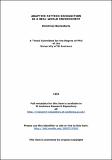Files in this item
Adaptive pattern recognition in a real-world environment
Item metadata
| dc.contributor.advisor | Livesey, Mike | |
| dc.contributor.author | Bairaktaris, Dmitrios | |
| dc.coverage.spatial | [9], 138 p. | en_US |
| dc.date.accessioned | 2016-08-04T16:09:24Z | |
| dc.date.available | 2016-08-04T16:09:24Z | |
| dc.date.issued | 1991 | |
| dc.identifier | uk.bl.ethos.314704 | |
| dc.identifier.uri | https://hdl.handle.net/10023/9261 | |
| dc.description.abstract | This thesis introduces and explores the notion of a real-world environment with respect to adaptive pattern recognition and neural network systems. It then examines the individual properties of a real-world environment and proposes Continuous Adaptation, Persistence of information and Context-sensitive recognition to be the major design criteria a neural network system in a real-world environment should satisfy. Based on these criteria, it then assesses the performance of Hopfield networks and Associative Memory systems and identifies their operational limitations. This leads to the introduction of Randomized Internal Representations, a novel class of neural network systems which stores information in a fully distributed way yet is capable of encoding and utilizing context. It then assesses the performance of Competitive Learning and Adaptive Resonance Theory systems and again having identified their operational weakness, it describes the Dynamic Adaptation Scheme which satisfies all three design criteria for a real-world environment. | en_US |
| dc.language.iso | en | en_US |
| dc.publisher | University of St Andrews | |
| dc.subject.lcc | Q335.B2 | |
| dc.subject.lcsh | Pattern recognition systems. | en_US |
| dc.subject.lcsh | Neural networks (Computer science) | en_US |
| dc.title | Adaptive pattern recognition in a real-world environment | en_US |
| dc.type | Thesis | en_US |
| dc.type.qualificationlevel | Doctoral | en_US |
| dc.type.qualificationname | PhD Doctor of Philosophy | en_US |
| dc.publisher.institution | The University of St Andrews | en_US |
This item appears in the following Collection(s)
Items in the St Andrews Research Repository are protected by copyright, with all rights reserved, unless otherwise indicated.

